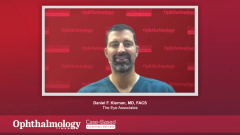
Impressions and Takeaways From Patient Case #2
Daniel F Kiernan, MD, FACS, discusses the use of anti-inflammatory treatment when experiencing sub-optimal response with anti-VEGF therapy in DME.
Daniel F. Kiernan MD, FACS: This is an interesting case because we see a number of good points. This patient who had very severe DME [diabetic macular edema] with poor vision from the onset, but still had to undergo step therapy, perhaps unnecessarily because there’s little effect of the bevacizumab before switching to ranibizumab. Because of compliance and various other factors, it’s hard to tell what the actual effect of the ranibizumab was. Be that as it may, the patient improved greatly with the combination therapy of a single dexamethasone corticosteroid implant, hopefully aimed at reducing the inflammatory cytokines that we see in so many diabetics, more of a chronic inflammatory nature rather than the VEGF given acute nature of some DME. This patient did well after combination therapy. They were switched to aflibercept for one reason or another, and what was nice was they were able to be maintained on the aflibercept every other month without the need for an additional corticosteroid implant. The corticosteroids are great for reducing the cytokine overload, the cytokine storm we see in diabetic macular edema. They do have untoward side effects, such as cataract progression and increased intraocular pressure. In this patient, a younger phakic patient, we like to avoid the formation of cataract with the resultant vision loss. That is my treatment strategy for a lot of diabetic patients, trying to get them stabilized with anti-VEGF biologics. But if that wasn’t going to happen, then oftentimes I’ll turn towards another option, like a corticosteroid dexamethasone implant, to see if they have an effect with that. And then, if they can be maintained on the original anti-VEGFs, then that is an ideal scenario. When do I use laser focal, PRP [panretinal photocoagulation] for eyes with DME? In this case, and in other cases, if the patient has high-risk proliferative diabetic retinopathy, I will apply PRP to try and stabilize that and stave off any vitreous hemorrhage or other problems that may develop. Focal laser I use sparingly, for non-center involved diabetic macular edema. If we see lots of exudates with retinal thickening or big, juicy microaneurysms, those are great targets for focal laser. But, center-involved focal laser has no place now in treating these patients, as we saw from the DRCR [Diabetic Retinopathy Clinical Research Network] Protocol I. Delayed or concurrent focal laser is still not as beneficial as anti-VEGF, whether it be ranibizumab in Protocol I, or even bevacizumab or aflibercept as seen in Protocol T. Center-involved focal laser should have a sparing place in treating diabetic macular edema patients. Thank you for watching this Ophthalmology Times® presentation. We hope you found this presentation informative and applicable in your practice.
Transcript edited for clarity
Newsletter
Don’t miss out—get Ophthalmology Times updates on the latest clinical advancements and expert interviews, straight to your inbox.














































